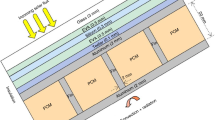Abstract
A high photovoltaic (PV) panel temperature causes a reduction in the terminal voltage that results in low output power. Therefore, the extraction of heat from PV panels is a very important and crucial area to enhance the electrical power output. A PVT (Photovoltaic-Thermal) is a combined version of photovoltaics and solar thermal collector to generate electrical and thermal energies. Despite its popularity, the thermo-electrical performance of water-based PVT systems is not up to the mark because of the poor thermal conductivity of water. The present work experimentally investigates the concentration and MFR (mass flow rate) variations of copper (Cu) and titanium oxide (TiO2) nanofluids on the performance of a hybrid PVT system. The developed model is deployed to examine the performance of the PVT system for the weather conditions of Ghaziabad city (India). The research outcomes show how the PVT with Cu/water nanofluid exhibits a better thermo-electrical performance as compared to the PVT with TiO2/water nanofluid and water cooling. The results also show that using Cu/water nanofluid (1 vol %) as a coolant improved the PVT electrical efficiency by 5.98% concerning the basefluid. At a higher MFR, the average PV panel temperature is reduced that results in better cooling of the PVT system. At 0.03 kg/s MFR, a reduction in 17.18 °C temperature in the PV panel enhances the thermo-electrical efficiency by 2.58% and 5.43%, respectively.
Graphical abstract
-
The present paper investigates the thermo-electrical performance of serpentine tube-based PVT collector with Cu/water and TiO2/water nanofluid.
-
The influence of nanofluid type and concentration on PV temperature (TPV), electrical efficiency (ηel), thermal efficiency (ηTh), and overall efficiency (ηPVT) are evaluated experimentally.
-
The energy balance equations of PVT collectors with nanofluid are derived from analyzing the impact of operating parameters.




















Similar content being viewed by others
Abbreviations
- A c :
-
Area of collector [m2]
- c p :
-
Heat capacity of fluid [J/kg−1 K−1]
- d :
-
Nanoparticle diameter [m]
- D in :
-
Inner tube diameter [m]
- D out :
-
Outer tube diameter [m]
- F :
-
Coefficient of friction, dimensionless
- G :
-
Incident solar radiation [W/m−2]
- h :
-
Air heat transfer coefficient [W/m−2.K−1]
- H :
-
Conductive heat transfer coefficient [W/m−2.K−1]
- L c :
-
Tube length [m]
- m :
-
Mass flow rate of fluid [kgs−1]
- N u :
-
Nusselt number, dimensionless
- P :
-
Packing factor of the cell
- Pe :
-
Peclet number, dimensionless
- Pr :
-
Prandtl number, dimensionless
- Re :
-
Reynolds number, dimensionless
- T :
-
Temperature [K]
- V f :
-
Volume flow rate [m3sec−1]
- v w :
-
Wind speed [msec−1]
- W :
-
Distance from tube to tube [m
- air:
-
Layer of air
- Ab:
-
Absorber layer
- bf:
-
Base fluid
- cell:
-
Photovoltaic cell
- g:
-
Glass cover
- ins:
-
Insulation layer
- nf:
-
Nanofluid
- pv:
-
Photovoltaic module
- t:
-
Tube
- th:
-
Thermal
- α :
-
Absorptance
- ρ :
-
Density [kg.m−3]
- ɳ 0 :
-
Efficiency at STC [%]
- ɳ el :
-
Electrical efficiency [%]
- ɳ PVT :
-
Overall efficiency [%]
- β 0 :
-
Temperature coefficient of efficiency
- λ :
-
Thermal conductivity [Wm−1 K−1]
- ɳ Th :
-
Thermal efficiency [%]
- δ :
-
Thickness [m]
- υ :
-
Viscosity of fluid [Pa.s]
- ϕ :
-
Volume fraction of nanoparticles
- MFR:
-
Mass flow rate
- HTF:
-
Heat transfer fluid
- PCM:
-
Phase change material
- PVT:
-
Photovoltaic thermal system
- PV:
-
Photovoltaic
- HTC:
-
Heat transfer coefficient
- MFR:
-
Mass flow rate
- HTF:
-
Heat transfer fluid
- PCM:
-
Phase change material
- PVT:
-
Photovoltaic thermal system
- PV:
-
Photovoltaic
- HTC:
-
Heat transfer coefficient
References
Calise F, Accadia MD, Piacentino A (2014) A novel solar trigeneration system integrating PV/T (photovoltaic/thermal collectors) and SW (seawater) desalination: dynamic simulation and economic assessment. Energy 67(2014):129–148
Gupta A, Agrawal S, Pal Y (2022) Energy and exergy performance evaluation of a novel photovoltaic-thermoelectric system combined with tube and sheet serpentine water collector. Int J Green Energy 19(4):365–379. https://doi.org/10.1080/15435075.2021.1946814
Kazem HA (2019) Evaluation and analysis of water-based photovoltaic/thermal (PV/T) system. Case Stud Therm Eng 13:100401
Beath AC (2012) Industrial energy usage in Australia and the potential for implementation of solar thermal heat and power. Energy 43(1):261–272
Gupta A, Diwania S, Agrawal S, Siddiqui AS, Pal Y (2020) A bibliographical view on research and developments of photovoltaic and thermal technologies as a combined system: PV/T system. In: Kalam A, Niazi K, Soni A, Siddiqui S, Mundra A (eds) Intelligent computing techniques for smart energy systems. Lecture notes in electrical engineering, vol 607. Springer, Singapore. https://doi.org/10.1007/978-981-15-0214-9_74
Diwania S, Siddiqui AS, Agrawal S, Kumar R (2021) Performance assessment of PVT-air collector with V-groove absorber: a theoretical and experimental analysis. Heat Mass Transfer 57:665–679. https://doi.org/10.1007/s00231-020-02980-0
Sopian K, Al-Waeli AHA, Kazem HA (2020) Energy, exergy and efficiency of four photovoltaic thermal collectors with different energy storage material. J Energy Storage 29:101245
Diwania S, Siddiqui AS, Agrawal S, Kumar R (2021) Modeling and assessment of the thermo-electrical performance of a photovoltaic-thermal (PVT) system using different nanofluids. J Braz Soc Mech Sci Eng 43:190. https://doi.org/10.1007/s40430-021-02909-6
Al-Waeli AHA, Chaichan MA, Kazem HA, Sopian K (2019) Evaluation and analysis of nanofluid and surfactant impact on photovoltaic-thermal systems. Case Stud Therm Eng 13:100392
Wahab A, Hassan A, Qasim MA, Ali HM, Babar H, Sazid MU (2019) Solar energy systems-Potential of nanofluids. J Mol Liq 289:1110–1149
Al-Waeli AHA, Kazem HA, Chaichan MA, Sopian K (2019) Experimental investigation of using nano-PCM/nanofluid on a photovoltaic-thermal system (PVT): technical and economic study. Thermal Sci Eng Progress 11:213–230
Farhana K, Kadirgama K, Rahman MM, Ramasamy D, Noor MM, Najafi G, Samykano M, Mahamude ASF (2019) Improvements in the performance of solar collectors with nanofluids—a start of the art review. Nano-Struct Nano-Objects 18:100276
Ghadiri M, Sardarabadi M, Pasandideh-fard M, Moghadam AJ (2015) Experimental investigation of a PV/T system performance using nano ferrofluids. Energy Convers Manag 103:468–476
Rejeb O, Sardarabadi M, Ménézo C, Passandideh-Fard M, Dhaou MH, Jemni A (2016) Numerical and model validation of uncovered nanofluid sheet and tube type photovoltaic thermal solar system. Energy Convers Manag 110:367–377
Bianco V, Scarpa F, Tagliafico LA (2018) Numerical analysis of Al2O3–water nanofluid forced laminar convection in an asymmetric heated channel for application in flat plate PV/T collector. Renew Energy 116:9–21
Al-Waeli AHA, Chaichan MT, Kazem HA, Sopian K, Ibrahim A, Mat S, Ruslan MH (2018) Comparison study of indoor/outdoor experiments of a photovoltaic thermal PV/T system containing SiC nanofluid as a coolant. Energy 151:33–44
Fudholi A, Razali NFM, Yazdi MH, Ibrahim A, Ruslan MH, Othman MY, Sopian K (2019) TiO2/water-based photovoltaic thermal (PVT) collector: novel theoretical approach. Energy. https://doi.org/10.1016/j.energy.2019.06.143
Hissouf M, Feddaoui M, Najim M, Charef A (2020) Numerical study of a covered photovoltaic-thermal collector (PVT) enhancement using nanofluids. Sol Energy 199:115–127
Al-Shamani AN, Sopian K, Mat S, Hasan HA, Abed AM, Ruslan MH (2014) Experimental studies of rectangular tube absorber photovoltaic thermal collector with various types of nanofluids under the tropical climate conditions. Energy Convers Manag 124:528–542
Moradgholi M, Nowee SM, Farzaneh A (2018) Experimental study of using Al2O3/methanol nanofluid in a two phase closed thermosyphons (TPCT) array as a novel photovoltaic/thermal system. Sol Energy 164:243–250
Khanjari Y, Pourfayaz F, Kasaeian AB (2016) Numerical investigation on using of nanofluid in a water-cooled photovoltaic thermal system. Energy Convers Manag 122:263–278
Nasrin R, Rahim NA, Fayaz H, Hasanuzzaman M (2018) Water/MWCNT nanofluid based cooling system of PVT: experimental and numerical research. Renewable Energy 121:286–300
Hader M, Al-Kouz W (2018) Performance of hybrid photovoltaic/thermal system utilizing water-Al2O3 nano-fluids and fin. Int J Energy Res 43:219–230
Lari MO, Sahin AZ (2017) Design, performance and economic analysis of a nanofluid based photovoltaic thermal systems for residential applications. Energy Convers Manag 149:467–484
Alous M, Kayfeci M, Uysal A (2019) Experimental investigations of using MWCNTs and graphene nanoplatelets water- based nanofluids as coolants in PVT systems. Appl Thermal Eng 162:114265
Hosseinzadeh M, Sardarabadi M, Passandidehfard M (2018) Energy and Exergy analysis of nanofluid based Photovoltaic thermal system integrated with phase change material. Energy. https://doi.org/10.1016/j.energy.2018.01.073
Kandilli C (2019) Energy, exergy and economic analysis of a photovoltaic thermal system integrated with the natural zeolites for heat management. Int J Energy Res 43:4670–4685
Manigandan S, Kumar V (2019) Comparative study to use nanofluid ZnO and CuO with phase change material in photovoltaic thermal systems. Int J Energy Res 43:1882–1891
Rajaee F, Rad MAV, Kasaeian A, Mahian O, Yan WM (2020) Experimental analysis of a photovoltaic/thermoelectric generator using cobalt oxide nanofluid and phase change material for heat sink. Energy Convers Manag 212:112780
Jia Y, Ran F, Zhu C, Fang G (2020) Numerical analysis of photovoltaic-thermal collector using nanofluid as a coolant. Sol Energy 196:625–636
Pak BC, Cho YI (1998) Hydrodynamic and heat transfer study of dispersed fluids with submicron metallic oxide particles. Exp Heat Transf Int J 11:151–170
Xuan Y, Li Q (2003) Investigation on convective heat transfer and flow features of nanofluids. J Heat Transfer 125:151–155
Diwania S, Agrawal S, Siddiqui AS, Singh S (2019) Photovoltaic-thermal (PV/T) technology: a comprehensive review on application and its advancement. Int J Energy Environ Eng 11:33–54
Holman JP (2012) Experimental methods for Engineers. Mc-Graw-Hill, New York
Author information
Authors and Affiliations
Corresponding author
Additional information
Technical Editor: Ahmad Arabkoohsar.
Publisher's Note
Springer Nature remains neutral with regard to jurisdictional claims in published maps and institutional affiliations.
This article has been selected for a Topical Issue of this journal on Nanoparticles and Passive-Enhancement Methods in Energy.
Rights and permissions
About this article
Cite this article
Diwania, S., Kumar, R., Singh, S.K. et al. Performance assessment of a serpentine tube PVT system using Cu and TiO2 nanofluids: an experimental study. J Braz. Soc. Mech. Sci. Eng. 44, 71 (2022). https://doi.org/10.1007/s40430-022-03366-5
Received:
Accepted:
Published:
DOI: https://doi.org/10.1007/s40430-022-03366-5




